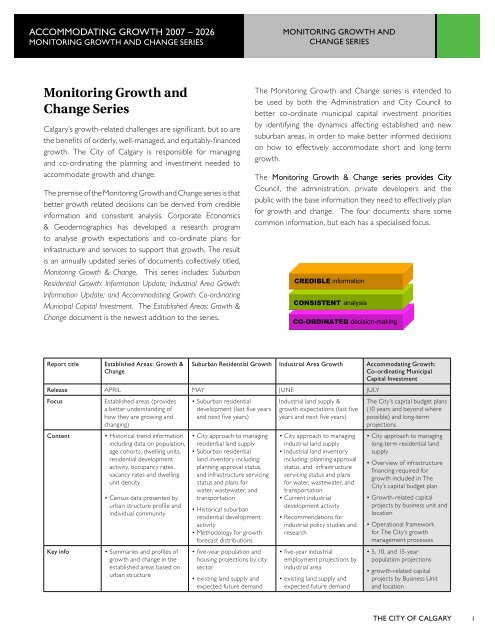Accommodating_growth_one
Accommodating_growth_one
Accommodating_growth_one
Create successful ePaper yourself
Turn your PDF publications into a flip-book with our unique Google optimized e-Paper software.
accommodating <strong>growth</strong> 2007 – 2026<br />
monitoring <strong>growth</strong> and change series<br />
Monitoring <strong>growth</strong> and<br />
change series<br />
Monitoring Growth and<br />
Change Series<br />
Calgary’s <strong>growth</strong>-related challenges are significant, but so are<br />
the benefits of orderly, well-managed, and equitably-financed<br />
<strong>growth</strong>. The City of Calgary is responsible for managing<br />
and co-ordinating the planning and investment needed to<br />
accommodate <strong>growth</strong> and change.<br />
The premise of the Monitoring Growth and Change series is that<br />
better <strong>growth</strong> related decisions can be derived from credible<br />
information and consistent analysis. Corporate Economics<br />
& Geodemographics has developed a research program<br />
to analyse <strong>growth</strong> expectations and co-ordinate plans for<br />
infrastructure and services to support that <strong>growth</strong>. The result<br />
is an annually updated series of documents collectively titled,<br />
Monitoring Growth & Change. This series includes: Suburban<br />
Residential Growth: Information Update; Industrial Area Growth:<br />
Information Update; and <strong>Accommodating</strong> Growth: Co-ordinating<br />
Municipal Capital Investment. The Established Areas: Growth &<br />
Change document is the newest addition to the series.<br />
The Monitoring Growth and Change series is intended to<br />
be used by both the Administration and City Council to<br />
better co-ordinate municipal capital investment priorities<br />
by identifying the dynamics affecting established and new<br />
suburban areas, in order to make better informed decisions<br />
on how to effectively accommodate short and long-term<br />
<strong>growth</strong>.<br />
The Monitoring Growth & Change series provides City<br />
Council, the administration, private developers and the<br />
public with the base information they need to effectively plan<br />
for <strong>growth</strong> and change. The four documents share some<br />
common information, but each has a specialised focus.<br />
CREDIBLE information<br />
CONSISTENT analysis<br />
CO-ORDINATED decision-making<br />
Report title<br />
Established Areas: Growth &<br />
Change<br />
Suburban Residential Growth Industrial Area Growth <strong>Accommodating</strong> Growth:<br />
Co-ordinating Municipal<br />
Capital Investment<br />
Release APRIL MAY JUNE JULY<br />
Focus<br />
Content<br />
Key info<br />
Established areas (provides<br />
a better understanding of<br />
how they are growing and<br />
changing)<br />
• Historical trend information<br />
including data on population,<br />
age cohorts, dwelling units,<br />
residential development<br />
activity, occupancy rates,<br />
vacancy rates and dwelling<br />
unit density<br />
• Census data presented by<br />
urban structure profile and<br />
individual community<br />
• Summaries and profiles of<br />
<strong>growth</strong> and change in the<br />
established areas based on<br />
urban structure<br />
• Suburban residential<br />
development (last five years<br />
and next five years)<br />
• City approach to managing<br />
residential land supply<br />
• Suburban residential<br />
land inventory including:<br />
planning approval status,<br />
and infrastructure servicing<br />
status and plans for<br />
water, wastewater, and<br />
transportation<br />
• Historical suburban<br />
residential development<br />
activity<br />
• Methodology for <strong>growth</strong><br />
forecast distributions<br />
• five-year population and<br />
housing projections by city<br />
sector<br />
• existing land supply and<br />
expected future demand<br />
Industrial land supply &<br />
<strong>growth</strong> expectations (last five<br />
years and next five years)<br />
• City approach to managing<br />
industrial land supply<br />
• Industrial land inventory<br />
including: planning approval<br />
status, and infrastructure<br />
servicing status and plans<br />
for water, wastewater, and<br />
transportation<br />
• Current industrial<br />
development activity<br />
• Recommendations for<br />
industrial policy studies and<br />
research<br />
• five-year industrial<br />
employment projections by<br />
industrial area<br />
• existing land supply and<br />
expected future demand<br />
The City’s capital budget plans<br />
(10 years and beyond where<br />
possible) and long-term<br />
projections<br />
• City approach to managing<br />
long-term residential land<br />
supply<br />
• Overview of infrastructure<br />
financing required for<br />
<strong>growth</strong> included in The<br />
City’s capital budget plan<br />
• Growth-related capital<br />
projects by business unit and<br />
location<br />
• Operational framework<br />
for The City’s <strong>growth</strong><br />
management processes<br />
• 5, 10, and 15-year<br />
population projections<br />
• <strong>growth</strong>-related capital<br />
projects by Business Unit<br />
and location<br />
the city of calgary
















